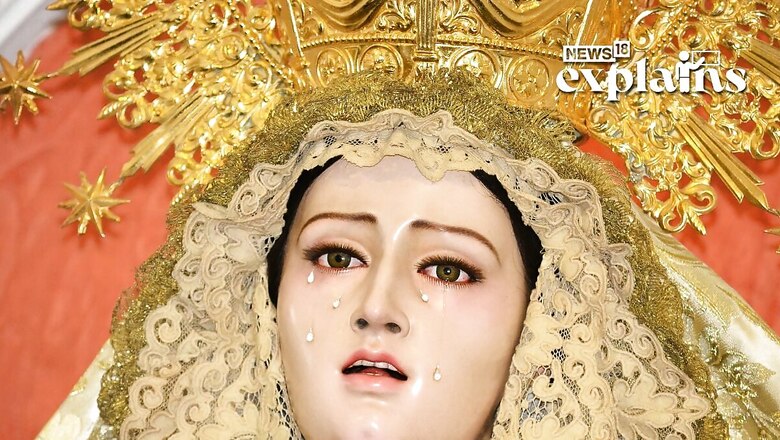
views
What was considered to be a ‘holy miracle’ has now led to a police chase against a woman who supposedly started it all. In a little lakeside hamlet near Rome, a woman known as “the Saint” disappeared after she claimed that a statue of a Virgin Mary wept blood-tears, causing pilgrims to flock the area for years.
Maria Giuseppe Scarpulla, a native of Sicily, and her husband are said to have left Trevignano Romano last week after a private eye allegedly opened a criminal case against her based on his claims that the blood spots on the statue were caused by a pig, said a report by the Guardian.
The strange tale started in 2016 when Scarpulla, also known as Gisella Cardia to her devotees, purchased the statue from a Catholic shrine in Medjugorje, Bosnia. When she got back to Italy, she said the Madonna was sending her messages and crying blood.
The ‘Saint’s’ Fraud
In a park with a view of Lake Bracciano, the statue was housed in a glass case. On the third day of every month, hundreds of pilgrims would gather there to pray and hear the most recent revelations from God, many of whom were hoping for a cure for life-threatening illnesses, the report says.
Scarpulla, who had previously been found guilty of bankruptcy fraud, established a foundation through which she solicited funds for building a facility for ill children.
A local bishop, Marco Salvi, declared in March that the church would look into the phenomenon surrounding the site, which is a plot of property in the park that was allegedly purchased with contributions, amid increased media interest in it and complaints from residents about the frequent flood of pilgrims.
A rough estimate of 300 pilgrims from all across Italy flocked there on April 3 for the monthly event, during which Scarpulla said she had received another communication from the Virgin Mary, despite doubts about the assertions.
Two days later, the private detective Andrea Cacciotti informed the Italian media that he had reported the incident to the local Civitavecchia police and prosecutors because “too many people felt they had been duped,” the report by Guardian said.
Catholicism’s Long History With Weeping Marys
Catholicism has a long history of making claims about paranormal events, including crying statues. The Madonna of Syracuse, Sicily, a plaster figure that has sobbed since 1953, is a well-known example, according to a report by the Conversation. In reality, weeping sculptures were reported in a number of countries last year, including Hungary, Argentina, and Macedonia.
It’s critical to acknowledge the relationship between miracles and the Virgin Mary in order to see why a weeping statue might have theological significance, the report says. Catholics hold that Mary is the mother of God since she is the mother of Jesus Christ. Supernatural occurrences have been attributed to Mary’s authority throughout Catholic history.
Three priests miraculously avoided the heat and flames while protecting Mary’s relic, known as “The Veil of the Virgin,” during the fire that destroyed France’s Chartres Cathedral. The victory in the Battle of Lepanto in 1571, when an Ottoman fleet was repelled by the forces of Genoa, Venice, and the papacy, is likewise thought to have been made possible by Mary’s intercession.
For Catholics, Mary’s tears have a special meaning since she weeps not only for the sins of the world but also for the suffering she went through during her earthly existence, known as “the seven sorrows of Mary.” Seven swords pierce Mary’s blazing heart, signifying her sorrows, which include the crucifixion and death of Jesus, the Conversation report explains.
How The Church Tests Tear Trickery
Bishops are directed by guidelines established by the Vatican’s Congregation for the teaching of the Faith, which regulates Catholic teaching, when evaluating claims of the supernatural. The influence of the supernatural phenomenon on the community is assessed by the bishop or a commission that he appoints. Positive outcomes include healings, conversions, and even a broader, deeperening of Catholics’ faith. Negative characteristics might include sinful actions like making statements that are in conflict with Catholic doctrine or selling oil from a statue that is weeping, the report explains.
Whether the event has been staged is one of the main queries. For instance, it was discovered that the blood shed by two statues that sobbed in 1986 and 2006 in Italy and Canada respectively was the owner’s. The porous material of sculptures can be penetrated with liquids, which later seep out as “tears.” When the temperature in the chapel rises, oil mixed with fat can be added to a statue’s eyes, which will cause them to “weep.”
Read all the Latest Explainers here

















Comments
0 comment